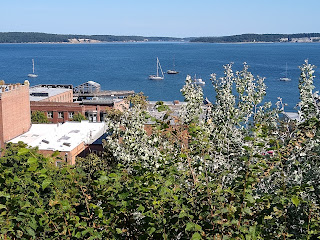Our previous post on Pitship Point introduced you to some
history of John Wayne Marina and included a historical picture of a long dump
near Johnson Creek, likely dating back to the turn of the 20
th
century. We skip ahead a decade or two with a picture taken only a hundred
yards or so east of that previous shot.
 |
| Then - Johnson Creek Auto Camp (unknown date) / Now - John Wayne's Waterfront Resort (2020) |
This image comes to us from the
Museum and Arts Center in Sequim-Dungeness, featuring what was known then as Johnson Creek Auto Camp.
Again undated, but with cars that I believe date to the 1920’s, this photo
shows the early cabins of a campground that later would be called Silver Sands
Resort and is now part of John Wayne’s Waterfront Resort on the western shore of Sequim Bay. The shoreline and primary use of this property hasn't changed much in nearly 100 years. The one exception, Whitefeather Way now separates the larger building on the left from the cabins on the right.
 |
| Newspaper ad from May 1957 |
I presume the cabins in our
Then picture were built in 1910,
but I don’t believe any remain (although the county assessor lists 1910 as the
“built date” of the current cabins). According to a
2017 Peninsula Daily News “Back When” column, which features a postcard picture of Silver Sands
Resort in the 1960s, locals recall the old cabins were replaced by the current
structures after World War II. Ads for Silver Sands Resort in the Port Angeles
Evening News start mentioning “new cabins”
around 1960. Adjacent to Silver Sands was Hague’s Resort with apartments, camping, boat ramp and saltwater swimming lagoon. Both resorts were sold in the late 1960s to
Sequim Bay Marina, Inc. (actor John Wayne), later becoming the RV park, camping and cabins you can visit today. Unfortunately, information
or advertisements from the Johnson Creek Auto Camp era have been hard to track down.
 |
| Same tree? |
For me, the fun of Now and Then photos is spotting landmarks, buildings or items that survived the intervening years and appear in both photos. After turning the brightness
up all the way on our old photo, I spotted something that I believe has
remained, although now only in part. A unique tree with multiple trunks can be seen in the old photo in nearly the same spot we
currently find an enormous stump, just outside the second cabin from the left.
Lucky for us, Silver Sands Resort sold numerous postcard
photos of their cabins in the 1960s and we can see the tree in all its glory. I
can't be absolutely certain it is the same tree we see in the Johnson Creek Auto Camp photo, but the position and uniqueness of the tree itself make me feel confident that
it is the same one.
 |
| Postcards from Silver Sands Resort in the 1960s |
If you have any additional information about this location before it was Silver Sands Resort, please let us know.









































